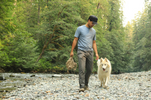
Dogs Feel Our Energy — Here’s How to Use That to Create Calm
, by Majella Gee, 25 min reading time

, by Majella Gee, 25 min reading time
Holistic guidance on emotional mirroring, energy awareness, and mindful communication with dogs.
We say dogs “just know.” They do — but not by magic.
Dogs read us through scent (stress hormones), posture, breath, voice tone, eye contact, and routine. Your dog’s nervous system is constantly checking yours: Are we safe? Are we tense? Are we rushing?
When our energy is scattered, our dogs absorb it. When we’re grounded, they exhale.
This isn’t mystical — it’s biology. Change what you bring to a moment, and your dog changes with you.

What “energy” really means
When we talk about energy, it’s not something invisible or abstract. It’s the real, physical signals you send out every second:
Dogs don’t just notice these things — they mirror them. That’s emotional co-regulation in action.
The Calm Owner Toolkit
1.0The Two-Minute Reset (before anything important)
Before every walk, meal, training session, or greeting:
Predictable calm from you equals predictable calm from your dog.
2. Never Walk Angry
If you’ve just had an argument, you’re frustrated, or your nerves are frayed — don’t grab the leash to “blow off steam.”
Your dog will absorb every ounce of that energy. What feels like stress relief for you can be overwhelming for them.
Angry walks teach dogs that the world outside equals tension and unpredictability.
If you’re upset, calm yourself first — breathe, move, stretch, cry, meditate, whatever works.
Only once you feel genuinely settled should you clip on that lead.
Dogs pick up on the slightest mood shift. You can’t fake calm around them. They know, long before anyone else does.
3. The 90-Second Rule
When your dog is amped up, give them 90 seconds of calm co-regulation before asking anything:
Most dogs will start to yawn, lick, or soften their body within a minute. That’s your cue they’re ready to listen again.
4. Calm Touch, Not Clutch
Long, slow strokes from shoulder to hip — not frantic pats or hovering hands.
Pause often and let your dog invite more contact. Consent builds trust.
5. Voice That Soothes
Drop your tone and halve your talking speed.
Avoid sing-song baby talk when they’re anxious — it adds stimulation.
Aim for the tone you’d use reading to a sleepy child: gentle, low, steady.
6. Soft Eyes & Sideways Body
Don’t stare directly — it feels threatening to dogs.
Blink, soften, look slightly away.
Turn your body 30–45° to the side; it’s polite in dog language.

Using Your Energy in Everyday Flashpoints
🚪 Doorbell & Visitors
The key: your tempo sets theirs.
🐕 Leash Reactivity
Before stepping outside, run your two-minute reset.
On walks:
🌩️ Thunder, Fireworks & Storms
🩺 Vets & Grooming
Practise “pretend vet” touches at home — ears, paws, tail — always paired with calm breath and gentle reward.
At the vet, sit side-on, stroke once, stop, feed.
Small, predictable movements build huge trust.

Calm Station Training
How Your Environment Affects Energy
Reading the “Calm Meter”
Green zone: soft eyes, relaxed body, taking treats — learning is possible.
Amber: tight face, weight forward, faster breathing — manage it.
Red: barking, ignoring food, pupils dilated — stop, create space, breathe together.
Never train in the red zone. Wait for green.

Guests, Kids, and High Energy Humans
Multi-Dog Homes

Common Mistakes That Hype Dogs
A One-Week Calm Challenge
Each day:
Track:
You’ll see shifts by Day 4 or 5 — not perfection, but softness. That’s your sign you’re communicating peace, not pressure.

Final Thoughts
Your dog’s calm begins with you.
If you bring tension, they’ll carry it.
If you bring steadiness, they’ll match it.
Before you grab the leash, open your mouth, or issue a command — breathe. Let go of the day. Show them safety through your stillness.
You don’t have to fake calm. You just have to choose it.
That’s how dogs learn to trust the moment — and you.
©Majella Gee 2025
#DogCalm #MindfulDogOwner #DogBehaviour #HolisticDogCare #CoRegulation #AustralianDogs #DogTrainingKindly #MajellasPetStore